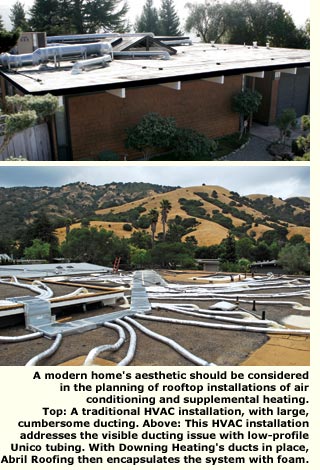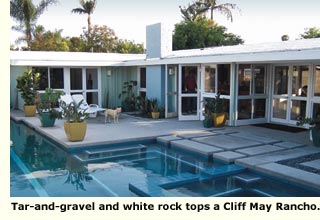Roofing Survival Guide - Page 2
Given the high cost of energy today, insulation is more important than it was in the past, especially for Eichlers and other mid-century modern homes as originally built 50 years ago. They tend to be 'energy hogs'—energy inefficient compared to recently built homes.
Roofers are under increasing pressure to develop cost-effective ways to add insulation to roofs, and the most common insulating material is foam. Whether installed as sheeting under tar-and-gravel, single-ply, or modified-bitumen systems, or applied as a spray-coated roofing material itself, two inches of foam can reduce interior summer heat by as much as eight to ten degrees.
Also, in the case of Eichlers, since original electrical systems were installed beneath the roofing material, the re-roofing process offers the homeowner the only practical window of opportunity to upgrade electrical (including wiring for ceiling light fixtures).
Skylights are another option to consider. If you're going to add skylights where none currently exist, re-roofing is the perfect time to do it. The roofing company, or a separate skylight company, can install them.
One Palo Alto Eichler owner reported that he added a room-size retractable skylight in his atrium during a re-roof. He chose foam roofing for the rest of the roof because it sealed tightly around these large openings at the ceiling.
Other opportunities also exist at re-roofing, such as reinforcing seismic stability or integrating plans for tying roof-based solar-electric systems, and air-conditioning and supplemental heating units (such as the foam-encapsulated Unico mini-duct system).
Finally, before finalizing any roofing decisions, investigate rebates that may be available from the city, county, or your local utility companies as a result of increasing your energy efficiency.
The scale and cost of roofing projects for mid-century modern homes really depend on the house. "You need to do a core test [examination of roof samples] before determining how much labor is involved in the project," says Chris Hemphill, Northern California regional representative for Duro-Last Roofing.

What's the condition of the roof? Are there drainage or depression issues? Is there visible damage or leaks? Is the home losing a lot of heat through the roof?
"[Some roofers] talk about insulation when they should be talking about waterproofing the building," Hemphill says. "Each building should be evaluated for its own experience and location. It doesn't make sense to put a lot of insulation on the roof if your windows and doors are leaking."
The price tag is always a factor. Costs can add up when a roof needs to be torn off and insulation added. (If your home already has two roofs, building codes require that you remove at least one layer.)
Shopping around for only the lowest price is not usually a smart move, since different roofing systems, and different installers, for that matter, may offer a different set of values. "Homeowners keep waiting to hear what they want to hear," Hemphill says. "They see a nice guy who gives them a good number, and they feel comfortable. Sometimes you have to bite the bullet and pay for a quality installation. If you don't, you might go to sell it [the house] in six or seven years, and end up losing value on resale."
What's the Best Roof for You?
Here is a breakdown of the most popular systems for homes with flat and low-sloped roofs:

Tar-and-Gravel System
One of the oldest roofing types used in residential construction, the tar-and-gravel system is also commonly referred to as 'built-up' because it involves multiple layers of material. Simply put, installers lay down a base sheet that is nailed in place and covered with layers of felt hot-mopped together with asphalt. The topcoat is then covered with a layer of gravel.
The gravel serves three purposes: protects the felt from the ultraviolet (UV) rays of the sun, improves aesthetics by providing an attractive and uniform surface, and aids in water evaporation by increasing the amount of surface area. However, because of the dark color (and poor reflectivity) of tar-and-gravel roofs, adding insulation to them is strongly recommended. If properly done, this layering process results in a roof that is watertight.
Generally, T&G is the least expensive of the five roofing systems, though the cost will be higher when add-ons, such as insulation and topcoats, are included. Also, some new building ordinances require positive roof drainage in order to pass roof inspection. Such drainage is accomplished by building up the roof with insulating material, which can increase the cost by as much as 50 percent.




